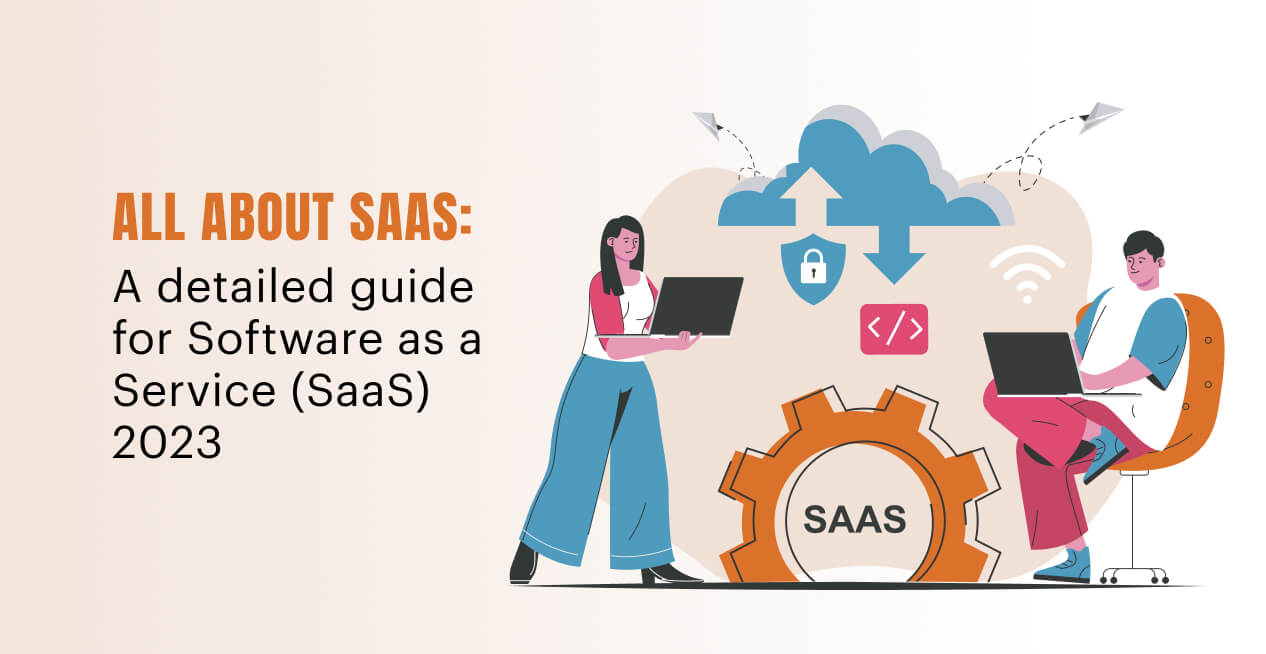-
Introduction
-
What is SaaS Software?
-
SaaS Companies
-
Steps to develop a SaaS product
- SaaS Solutions
- Why SaaS?- Advantages of using SaaS
-
Disadvantages of SaaS
-
Tips for finding a reliable SaaS Developer
-
How much does it cost to develop a SaaS platform?
- Our Success Stories
-
Are you looking to develop or scale up your SaaS product?
Introduction
Software as a Service or SaaS is taking the world by storm. Ever since 2020, the Covid Pandemic proved to businesses how having a digital presence was superior and reliable when traditional brick and mortar weren’t accessible. This further encouraged businesses in every aspect to go online which has resulted in SaaS being more popular than ever.
What is SaaS Software?
Going back to the 1960’s, SaaS began as an experimental “time sharing system” and “hosted Services” wherein a primitive cloud hosted an application which was accessed by not more than 2-3 people at a time. SaaS programming was basically invented to host multiple people and provide them with services in an era when computers and servers weren’t exactly affordable and space friendly, for small and medium businesses. Over the years it has evolved into a convenient, user-friendly software distribution system which are also major money makers given their recurring revenue model.
SaaS is now an effective way of delivering applications over the internet often freeing organisations from lengthy hardware and complex software management. Software as a Service is also known as web-based software or on-demand software which contributes a major chunk in cloud computing. In this computing model, business applications are hosted via a centralised host and can be accessed by various users via a subscription model or pay per use model.
SaaS Companies
SaaS Companies are businesses which host software on its own server, maintain its database, manage its hardware and offer users to the application through the internet while saving time, costs and energy for the company. In layman’s terms, the process is similar to buying bread from a nearby store instead of grinding flour in a mill and baking bread from scratch. Businesses can save time, money and labour all while subscribing to a read-to-use service rather than creating a customised software all on their own.
Steps to develop a SaaS product
Businesses developing a successful Saas product is simple, There are just few things that needs to be kept in mind:
- Start with an in-depth research of the market and product competitors.
- Choose an app monetisation model before you start designing your SaaS product.
- Look for a reliable cloud vendor. Since SaaS is cloud based, the right cloud vendor fit is a must.
- Pick a techstack according to the scale of your project, the technology required , and various third-party systems that might be integrated later.
- Design, develop, test, debug, and integrate.
- Release an MVP for the masses and keep improving your product with updates!
SaaS Solutions
With an increasing number of software companies migrating towards SaaS models, many categories of SaaS Solutions have cropped up based on their utility and nature of service. Each SaaS category is one of a kind and has been a blessing in disguise for business owners (hosts and users alike). Here are three most popular categories of saas products which have gained user loyalty for their intelligible solutions and feasibility.
Project Management SaaS Software
For businesses handling multiple projects of different time zones and different objectives, it can be a real challenge to manage all projects and its administrative tasks such as scheduling, assigning, planning and recording completion of these tasks. Project Management SaaS Software simplifies, organises and records such tasks in the best manner possible and facilitates product development on all levels. It makes it that much easier to delegate and define roles and responsibilities and map all tasks assigned. For small and medium enterprises who lack manpower, PM saas software often prove to be godsend.
Enterprise Resource Planning (ERP) Software
Another efficient tool for new-age businesses is Enterprise Resource Planning (aka ERP) software that helps automate day to day administrative and logistics chores such as sourcing, accounting, supply chain management, risk compliance, etc. ERP software organises these various processes in such a manner so as to minimise data duplication and ensure all data integrity of an organisation. According to a survey in 2020, 93% of organizations reported their ERP projects as successful.
Customer Relationship Management (CRM) Software
As Seibl Ad has rightly said, “Good Customer Service is good business”, it all comes down to a business’s interactions with a client. It can be a lengthy process to maintain and cater to customer needs throughout, before and after they have made purchase of a service or product. This is where customer relationship management software or a CRM software comes into play. A CRM helps small, medium and large enterprises to organise, automate and synchronise all aspects of customer relationships including customer service, sales pitch, marketing and grievance redressal.
Why SaaS?- Advantages of using SaaS
SaaS especially stands out for its unique characteristics which gives it a lot of leverage over other cloud computing models. Here listed are some of the features that saas can easily boast about.
Multi-tenant Hosting
Popular software development companies such as Salesforce, Github, and Hubspot are good SaaS examples of multi-tenant infrastructure. The concepts include hosting a software and its infrastructure and lending it to multiple users at any given time. Each user shares the software and its database all the while remaining invisible and maintaining data integrity from each other.
Single Sign On
While Multi-tenant hosting ensures sharing of data, Single Sign on makes it easier for the user to authenticate with multiple accounts and websites with one single set of credentials. This not only secures data from other businesses logged in to the software but also makes it convenient and user-friendly to access the software.
Elastic Infrastructure
Elastic infrastructure can be inferred as an infrastructure of any software or cloud computing model which delivers preconfigured virtual machine servers, storage services, and network connectivity at the tip of your fingers usually via a self-service interface. This type of infrastructure comes in handy as it provides IT resources required by any user conveniently and instantly.
Recurring Revenue model
Another alluring feature of the SaaS software is the recurring revenue it guarantees in the form of yearly or monthly subscriptions via a definite contract length. This ensures financial security to SaaS companies and ensures steady income.
Data Security
Since SaaS carries a huge database of corporate and individual data, businesses are often reluctant to shift from conventional in-house servers to cloud based servers. SaaS security addresses this concern by securing customer and corporate data in such cloud-based applications. It includes a set of tools built in the cloud which protects data from malware and phishing attacks and any potential exposure of client data.
High availability
All saas software can be accessed at any given time, without any interruptions for long periods of time. A highly available infrastructure like saas protects companies from losses incurred by unpredictable disruptions and consecutive delays to the entire processes.
Money Saver
Using and Developing SaaS Software reduces overhead and upfront costs significantly in the long run. A SaaS platform can cost anywhere between $50K and $500K to build. A mobile version can cost a little more. These costs are usually covered once the business starts earning recurring revenue via subscriptions and is a good investment for the long run.
Disadvantages of SaaS
- Compliance with contracts is not the easiest. Businesses not following stringent SaaS contracts are often penalised severely.
- Lack of control for businesses since the software is housed virtually and security is always a concern.
- Businesses have to deal with Laborious data integrations and low data mobility when they decide to stop using a particular SaaS platform.
Tips for finding a reliable SaaS Developer
If you are actively looking for SaaS developers can keep these pointers in mind:
- Identify your requirements for the project which generally includes the type of app, budgetary expectations and additions you might later want to incorporate in your product.
- Research SaaS development companies in your area and compare their portfolios. Glassdoor, Clutch, and GoodFirms are some of the portals that have genuine reviews.
- Watch out for the technical expertise of shortlisted companies and their history of SaaS development.
- Bring onboard experts, well-equipped with SaaS development skills. Research developers for SaaS experience stringently before onboarding them
How much does it cost to develop a SaaS platform?
Even though SaaS applications have revolutionised the software development industry in the last decade, many businesses are reluctant to develop SaaS platforms under the assumption that it is expensive to start with. This is untrue. Over the years the SaaS development costs have reduced. Today, the development cost of a minimum viable SaaS product can lie anywhere between $50,000-$150,000. There might be additional costs associated with SaaS development depending upon following few factors:
- How complex the functions and roles of the saas software is
- Number of development stages and its complexities
- Type of solutions
- Number of members client wants on a team
- Geographical location and demographics, who is the targeted audience
- Type of UI/UX the client wants, etc. All of these contribute to the varied developmental cost of a SaaS product.
Our Success Stories
OpenXcell has many successful SaaS projects to its credit. Three of the most popular being :
1. Orderhive
Orderhive is a multichannel order and inventory management system which was scaled up to provide end to end solutions to multichannel sellers. OpenXcell provided a team of highly qualified developers specialising in SaaS application development services to launch the product swiftly for initial trials. We also brought onboard experts to create the flagship software product. Orderhive is now one of the most renowned SaaS based platforms for ecommerce and multichannel inventory management while supporting 500+ integration making it convenient to import and export business data through multiple channels through a user friendly interface.
2. Serwiz
Serwiz is a multitasking lightweight CRM designed specifically for local service businesses. Serwiz is dedicated to helping small business owners save time and make optimum use of their resources. OpenXcell developed this unified CRM solution, keeping in mind the global requirements of various industries and consolidating all comprehensive features of many standard CRMs such as Hubspot, Zoho, etc.
3. AthleteGoLive
AthleteGoLive has been hailed as one of the most popular sports streaming platforms that provide live recordings and live-scoring of matches for sports enthusiasts. Built on .Net core and iOS swift code, this web application streams sports matches. OpenXcell helped to refurbish the application by providing its experienced team of developers that created a premium quality application to live stream games smoothly.
Are you looking to develop or scale up your SaaS product?
We, at OpenXcell, are a leading SaaS development company in India and USA. Our focus is on giving global clients high-quality and endurance. Our team of professionals is the creators and bespoken software services providers who continually endeavour to bring unique yet impeccable solutions to saas software development.
We offer quality resources, such as a dedicated team of SaaS developers who can create a unique, scalable, and secure platform to suit the demands of consumers in numerous business verticals.










